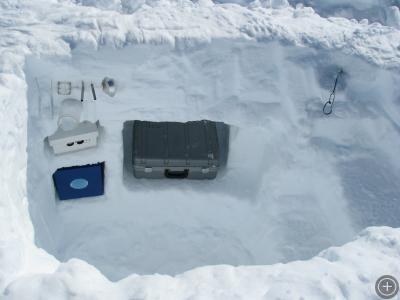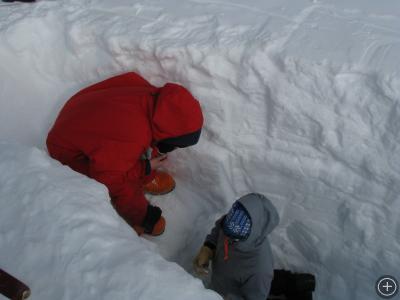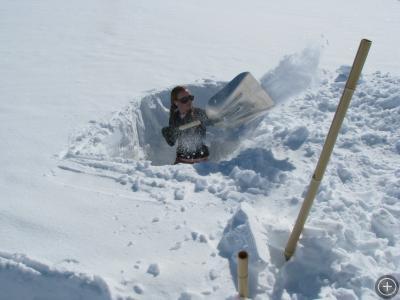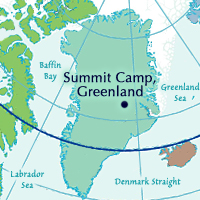It’s the Pits
SUMMIT CAMP, GREENLAND– We started the major task of our field season today: digging and sampling a three meter snow pit. This pit is located about a half mile outside of camp, in an area where no gas-powered vehicles (snowmobiles) or devices (generators) are allowed. Anything that emits pollution would contaminate other science groups’ measurements of atmosphere up here.
No snowmachines or generators usually means a long, slow walk through the snow pulling a sled piled with gear. This year though, thanks to a group of students at the University of Wisconsin who built a zero-emissions electric snowmobile, we were able to ride to and from our site in style.
The weather was great, and with the help of Tony Cummings, a senior at Georgia Tech here at Summit working with the HOx NOx group (a group of scientists studying the influence of sunlight on snow and atmospheric chemistry,) we were able to dig the big pit, and a smaller “lab” pit that we can work in, in a few short hours. I honestly don’t think that Tony knew what he was in store for, but I also think he enjoyed the good, hard work. Digging is very satisfying, and an excellent way to stay warm.
The lab pit is to keep the instruments and scientists out of the wind, and to keep the snow samples cold enough that they don’t melt on warm surfaces or start to change their structure. In the big pit, we are looking at a whole host of physical properties, and how these properties change over time.

Equipment in our lab pit. The grey box on the right is what we call our “permeameter”; it measures how easily air can move through snow. In the white box on the left is a thermal conductivity probe: a needle we push into the snow that heats to a certain temperature then provides us with thermal conductivity readings by measuring the time it takes to heat the snow. The blue box beneath the thermal conductivity probe is a stand for short snow/ice core sections. It isolates samples from the wind– an element that can easily disturb and affect the thermal conductivity measurements.
I had also dug pits here (dragging my gear out in a sled by foot) in the previous two years, and now I can trace the changes in the snow in the intervening time. Last year and the year before, I had put bamboo poles in the snow and tied a brightly colored string across the snow surface. I was able to find both of the strings in the pit, buried by the snow from this year and last. I was relieved and slightly surprised when they both popped up as we were digging.

Kristina stands on one of the pit steps while Maria takes density measurements inside. To take these measurements, we use a tool that cuts out 100 cubic centimeter blocks of snow, then measure the mass of these blocks.
Camp manager Kathy Young and science tech Steve Munsell stopped by our site on the way back to camp after a two hour ski. It was fun to have visitors.
We ended up having to go back out to our site after dinner when things had cooled down a bit. Earlier in the day, we had tried to hand drill a few short cores, but the cores kept getting stuck in the barrel, which was being warmed alarmingly by the sun. Coming out “at night” (it’s 24 hour daylight here now) means colder temperatures, and easier working conditions. Chris, the camp medic, apparently felt sorry for us, and brought out a much needed thermos of cocoa and some after-dinner mints. And then got roped into helping us cover up our pits. A great end to a great day.

 No comments
No comments 









